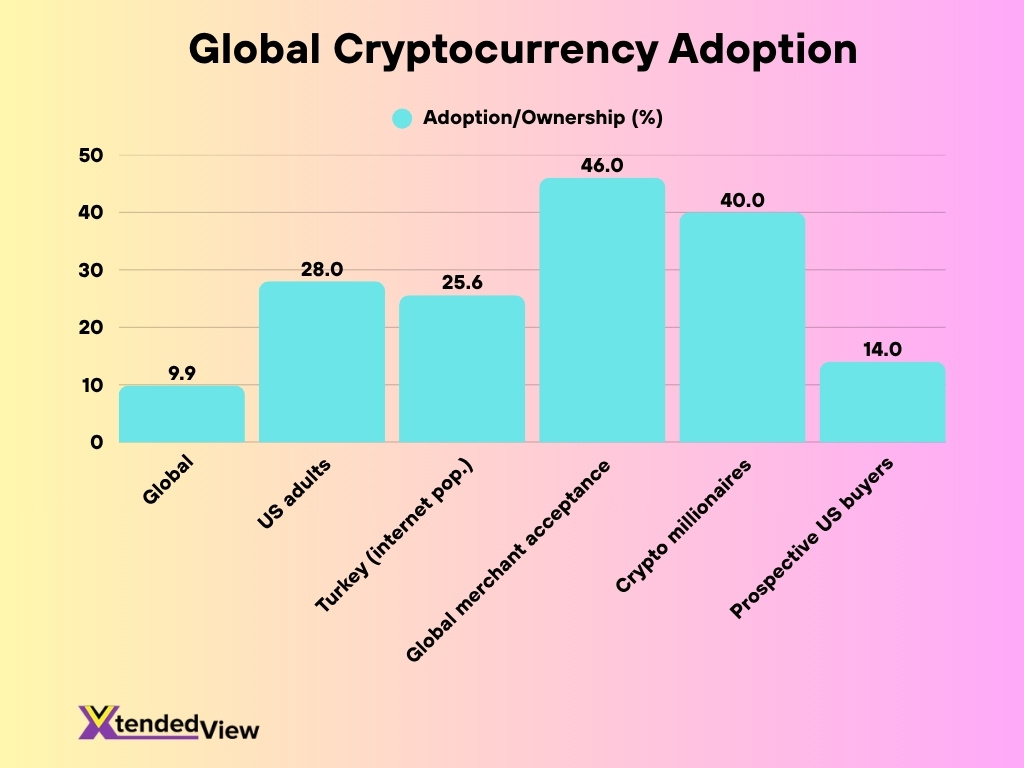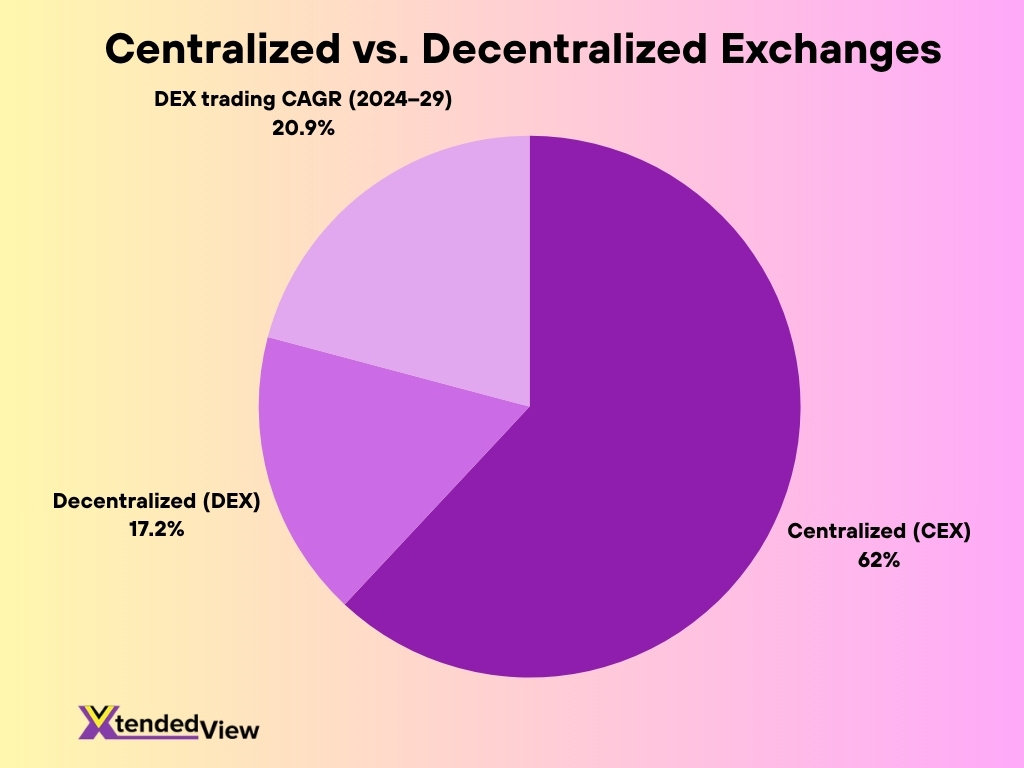Introduction
The cryptocurrency industry continues to evolve at a rapid pace. From institutional adoption to shifting global regulation, shaping up as a pivotal year for digital assets. In real‑world settings, for example, a U.S. retailer now accepts crypto for payments and a major fund allocates part of its portfolio to crypto instruments. These developments underscore how crypto is increasingly part of mainstream finance and commerce. Dive into the statistical details below to understand how the market is progressing and why it matters.
Editor’s Choice
Here are seven key statistics that set the tone for the cryptocurrency landscape in 2025:
- The global crypto market cap is estimated at over US $3.9 trillion in 2025.
- Global crypto adoption: around 9.9 % of the internet population now owns crypto (≈ 559 million people).
- In the Asia‑Pacific region, on‑chain value received rose by 69 % year‑over‑year (to about US $2.36 trillion) in the year ending June 2025.
- There are over 37 million unique cryptocurrencies created as of September 2025.
- In the United States, approximately 28 % of adults (≈ 65 million people) now own cryptocurrencies.
- More than 99 jurisdictions are working to implement the “Travel Rule” for virtual‑asset service providers (VASPs) in 2025.
- A dramatic regulatory milestone, the U.S. passed the GENIUS Act on July 18, 2025, to regulate payment stablecoins.
Recent Developments
- Legislation in the U.S. shifted significantly with the passage of the GENIUS Act, which sets a federal framework for stablecoins.
- Over 99 jurisdictions globally are either enacting or implementing rules to enforce VASP data sharing via the Travel Rule.
- The Asia‑Pacific region’s on‑chain crypto value grew from ~US $1.4 trillion to ~US $2.36 trillion in the 12 months ending June 2025 (+69 %).
- In Latin America, the growth in on‑chain value was ~63 % in the same period, and in Sub‑Saharan Africa, ~52 %.
- The U.S. regulatory tone shifted, the new administration created a crypto & AI task force, and changed accounting guidance (SAB 122) for custodied crypto assets.
- Major crypto payment options and merchant acceptance continue to grow, with stablecoins becoming more central in cross‑border payments and remittance flows.
- Tokenisation of real‑world assets is gaining traction under recent regulatory clarity, adding more institutional interest.
- The number of unique cryptocurrencies reached over 37 million in September 2025, showing extremely rapid creation of new tokens.
Cryptocurrency Market Overview
- As of 2025, the global cryptocurrency market cap is estimated at over US $3.9 trillion.
- One source estimates the current market cap at ~ US$3.79 trillion with a Bitcoin dominance of ~57.31 %.
- The number of distinct cryptocurrencies exceeds 18,000 per one report, while another count notes over 37 million unique tokens created.
- Daily global trading volumes in Q1 2025 dropped ~27.3 % quarter‑on‑quarter to ~US $146 billion.
- Volatility for Bitcoin has fallen, from an average of ~70 % during 2020‑22 to below 50 % after 2023.
- The crypto ecosystem is showing signs of consolidation, while the total market cap is large, many smaller tokens hold minimal value and liquidity.
- Institutional influences are growing, and crypto’s role as a portfolio diversifier is gaining acceptance under lower volatility conditions.
- A trend to note, real‑world asset tokenisation, stablecoins as a payment medium, and regulatory clarity are all shaping market structure rather than speculative peaks.
Global Cryptocurrency Adoption
- In 2025, the global crypto adoption rate (percentage of internet users) is ~9.9 %, equating to roughly 559 million crypto owners.
- This figure shows a marginal decline from 10.3 % in 2023.
- In the United States, about 28 % of adults (≈ 65 million people) owned cryptocurrencies in 2025.
- Among non‑owners in the U.S., 14 % plan to purchase crypto in 2025.
- Emerging economies lead adoption in some cases, for example, Turkey’s internet population has ~25.6 % owning crypto.
- The user base is still shifting, and growth in APAC, Latin America, and Africa is outpacing mature markets.
- Merchant acceptance is rising; one source estimates ~46 % of merchants globally accept crypto payments.
- Institutional and high‑net‑worth adoption is increasing; one report indicated over 241,700 crypto millionaires worldwide in 2025 (+40 %).

Top Cryptocurrencies by Market Capitalization
- As of October 2025, Bitcoin (BTC) remains the dominant cryptocurrency with a market cap of approximately US $1.49 trillion, representing about 38% of the total crypto market.
- Ethereum (ETH) follows with a market cap of around US $545 billion, accounting for 14% of total market capitalization.
- Tether (USDT) is the leading stablecoin by market cap, standing at over US$96 billion in 2025.
- BNB (formerly Binance Coin) holds the fourth position, with a market cap of roughly US$62 billion.
- Solana (SOL) surged into the top five with a market cap exceeding US $58 billion, driven by DeFi and NFT activity.
- XRP (Ripple) remains in the top 10, with a 2025 market cap of about US$33 billion, despite regulatory pressure.
- USD Coin (USDC) maintains a stable market cap of around US$54 billion, benefiting from institutional adoption.
- Cardano (ADA) and Avalanche (AVAX) round out the top 10, each with market caps in the US $15–22 billion range.
- Meme coins like Dogecoin (DOGE) and Shiba Inu (SHIB) remain in the top 20, supported by community interest and speculative trading.
- Combined, the top 10 cryptocurrencies account for over 85% of total global crypto market capitalization in 2025.
Cryptocurrency User Demographics
- In 2025, global crypto users surpassed 580 million, marking a 34 % year‑over‑year increase.
- The largest age group among crypto users is 25‑34 years, which accounts for about 31 % of users worldwide.
- Male users still dominate, making up approximately. 61 % of all crypto owners in 2025.
- A 2024 survey of U.S. households found crypto user share among Black and Hispanic individuals at 21 %, compared with 20 % for White individuals.
- About 65 % of U.S. crypto owners say they would like to make payments in crypto.
- In the U.S., 28 % of adults (≈ 65 million people) owned cryptocurrency in 2025.
- Among U.S. adults without crypto, 14 % plan to purchase crypto in 2025.
- About 80 % of crypto users live in urban or metropolitan areas, as of 2025.
- Investors in crypto on average allocated ~12 % of their portfolios to digital assets in 2025.
Regional Adoption and Geographic Distribution
- India and the United States lead the rankings for grassroots adoption in 2025.
- In the 12 months ending June 2025, the Asia‑Pacific region saw a 69 % year‑over‑year increase in on‑chain crypto value received.
- Between July 2022 and June 2025, Latin America recorded nearly US$1.5 trillion in crypto transaction volume.
- The U.S. market crypto activity surged by around 50 % between January and July 2025 compared with the same period in 2024.
- South Asia became the fastest‑growing region in early 2025, recording approximately an 80 % increase from 2024.
- Turkey has 25.6 % of its internet population owning crypto, and Brazil has 20.6 %.
- Germany shows a lower penetration with 8.9 % and France with 7.2 % of internet users owning crypto.
- The U.S. accounts for about 17.9 % of all global crypto exchange traffic.
- Regional infrastructure gaps remain, with many users in emerging markets relying on mobile‑first exchanges and P2P systems.
Cryptocurrency Trading Volume
- In August 2025, combined spot and derivatives trading on centralized exchanges hit a monthly high of US$9.72 trillion, up 7.58 % MoM.
- In Q3 2025, top centralized exchanges recorded US$5.1 trillion in spot trading volume, a 31.6 % increase from Q2.
- Perpetual derivatives trading volume on decentralized exchanges reached US$1.81 trillion, up 87 % from Q2.
- Decentralized exchanges represent about 21.7 % of all global crypto trading volume.
- DEX volume reached up to 36 % of CEX volume in Q3.
- Derivatives accounted for about 75.7 % of centralized exchanges’ activity in August 2025.
- Top 10 centralized exchanges and DEXs together recorded approximately US$15 trillion in spot trading volume in 2025.
- Spot trading for CEXs in August 2025 was ~US $2.36 trillion, with derivatives at US $7.36 trillion.
- CEXs are adopting audit and proof‑of‑reserves features to meet transparency demands.
Largest Cryptocurrency Exchanges
- Binance holds approximately 42.3 % of the global spot trading market share as of Q3 2025.
- Binance held 39.8 % of spot volume among CEXs in July 2025.
- MEXC is the second‑largest CEX with about 8.6 % market share.
- Gate.io holds about 7.8 % share, ranking third.
- Seven of the top ten exchanges saw volume declines in Q2 2025.
- The top 10 centralized exchanges accounted for about 90.76 % of market revenue in 2024.
- Coinbase recorded a 28 % YoY spot trading volume surge, reaching US$234 billion in Q2 2025.
- The combined market share of ranks 4‑10 among CEXs was about 43.8 %.
- Institutional investors account for about 42 % of total exchange trading volume in 2025.
Centralized vs Decentralized Exchanges
- Centralized exchanges lead with 78.3 % of global volume; DEXs hold 21.7 %.
- DEX trading is growing at a CAGR of ~26.37 % from 2024 to 2029.
- DEX perpetual trading volume reached US $1.81 trillion in Q3 2025.
- CEXs are integrating hybrid models with non‑custodial features.
- Regulatory pressure and security incidents are driving DEX growth.
- DEXs offer institutional‑grade analytics and advanced derivatives.
- Users and regulators are prioritizing custody‑risk, transparency, and governance.

Stablecoins Statistics
- Monthly adjusted stablecoin transaction volume reached US$1.25 trillion in September 2025.
- Annual stablecoin volume is approximately US $9 trillion, up 87 % year‑over‑year.
- Stablecoins represent around 30 % of on‑chain crypto volume.
- Total stablecoin supply exceeded US$300 billion in 2025.
- Ethereum and Tron processed US$772 billion in stablecoin trades.
- Cross‑border payments and remittances now drive most stablecoin use.
- Emerging chains and new issuers are growing beyond USDT and USDC.
- Regulators globally are targeting stablecoins as systemically important.
Institutional Investment in Cryptocurrency
- In 2025, 59% of institutional investors plan to allocate more than 5% of their assets under management (AUM) to crypto or related digital‑asset products.
- About 86% of institutions surveyed either hold digital assets already or plan exposure in 2025.
- Data from May 2025 show that bitcoin funds attracted net US$5.5 billion, while ether funds drew US$890 million.
- A survey found that 35% of institutional asset managers allocate between 1%‑5% of their portfolios to digital assets, among those with over US $500 billion AUM, 45% allocate over 1%.
- Corporate treasury holdings are rising; public firms hold just over 859,000 BTC, representing about 4% of the 21 million maximum supply.
- 93% of institutional investors in digital assets remain positive on blockchain technology as a long‑term play, despite volatility.
- 60% of institutions expect to have integrated AI‑driven risk assessment tools for crypto investments by Q1 2025.
- Institutional demand is cited as a key factor in 2025’s market transformation, with some sources pointing to roughly 50% growth in institutional flows compared to prior years.
Cryptocurrency Ownership By Country
- In the United States, approximately 28% of adults own cryptocurrencies as of 2025.
- Among U.S. crypto holders, about 73% say they plan to continue investing in 2025.
- Globally, 45% of crypto‑holders surveyed said they had difficulty filing taxes related to their holdings in 2025.
- 34% of crypto‑users cited the complexity of tax rules as their top challenge in 2025.
- The market for tokenized real‑world assets (RWAs) reached about US $24 billion in 2025, reflecting adoption by institutions across jurisdictions.
- 37% of crypto‑users reported making cross‑border transactions that may trigger multi‑jurisdiction tax obligations.
- In the U.S., starting January 1, 2025, brokers must report gross proceeds from users’ crypto sales to the IRS on Form 1099‑DA.
- Non‑compliance remains high; one study estimated crypto‑asset tax non‑compliance at approximately 88% among certain platform users.
Cryptocurrency Mining Statistics
- The global crypto‑mining market was valued at US $2.2 billion in 2024, and is projected to grow to US $3.3 billion by 2030, at a CAGR of ~6.9%.
- In 2025, mining profitability is under pressure, with hardware and electricity costs increasing and margins becoming tighter.
- There are 16 publicly listed crypto‑mining firms on NASDAQ as of early 2025, up from six in 2021, signalling institutionalisation of mining operations.
- The U.S. remains the leading bitcoin mining jurisdiction in 2025, benefitting from favourable regulatory environments and renewable‑energy sourcing.
- A mining‑equipment price example, the cost of newer ASIC machines in 2025 is estimated at around US $16 per terahash, down from about US $80 per terahash in 2022.
- Some reports indicated that bitcoin miners collectively produced approximately US$20 million worth of Bitcoin per day in early 2025.
- The mining landscape is evolving, halving cycles (e.g., bitcoin reward reductions) are less dominant than power‑infrastructure and regulatory costs in shaping returns.
Security Incidents and Crypto Crime
- In the first half of 2025, over US$2.17 billion worth of cryptocurrency was stolen in hacks and other incidents, with one hack accounting for about US$1.5 billion.
- Illicit crypto volume in 2025 is estimated to be around US$45 billion, representing about 0.4% of total crypto transaction volume.
- Violent “wrench attacks” (physical extortion targeting crypto holders) increased by approximately 90% in 2025.
- In 2024 alone, the FBI reported US$9.3 billion in crypto‑related losses (a 66% increase year‑on‑year).
- 9 out of 10 institutional crypto investors cite counter‑party risk as their most significant concern in 2025.
- Annual cybercrime cost projections estimate cryptocurrency‑related crime might cost the world US$30 billion by 2025.
- Multiple jurisdictions have flagged that only 40 of 138 assessed countries were “largely compliant” with global crypto‑asset standards as of April 2025.
Crypto Taxes and Regulation Statistics
- In the U.S., starting January 1, 2025, crypto brokers are required to report gross proceeds from digital‑asset sales on Form 1099‑DA.
- Globally, 89% of crypto users report uncertainty about at least one aspect of crypto‑tax reporting, and 45% say they had difficulty filing taxes in 2025.
- In Indonesia, from August 1, 2025, domestic crypto trades will incur a 0.21% tax (up from 0.1%) and foreign‑exchange trades a 1% tax (up from 0.2%).
- The global regulatory survey indicated the U.S. and EU remain major influences, with firms observing more regulatory clarity in 2025 than in prior years.
- Studies estimate that 88% of crypto‑asset users may be non‑compliant with tax rules in some markets.
- The broader crypto‑asset tax enforcement environment is intensifying, for instance, in one country tax authorities issued ~65,000 “nudge” letters to suspected crypto investors in 2024‑25.
- Regulatory frameworks for stablecoins and tokenised assets are advancing; the Guiding and Establishing National Innovation for US Stablecoins Act (GENIUS Act) was passed by the U.S. Senate and House in mid‑2025.

Environmental Impact of Cryptocurrencies
- Major mining operations are increasingly located near renewable‑energy sources (wind, solar, hydro) to reduce environmental footprint.
- The cost of electricity and carbon‑pricing risk are now major determinants of miner profitability, shifting focus from pure hardware competition.
- Some mining regions (e.g., in the U.S.) are implementing state‑level clean‑energy incentives for data‑centre‑type crypto‑mining operations.
- New machine‑efficiency improvements (for example, lower US$/terahash cost) reduce energy consumption per unit work, potentially lowering emissions intensity per coin mined.
- Analysts forecast moderate growth in the crypto‑mining market value but warn that regulatory risks (e.g., bans, carbon tariffs) may constrain growth in high‑emission jurisdictions.
- Some governments and mining firms are exploring carbon offsets and renewable‑energy credits to link mining operations with sustainability claims; uptake remains early.
- The environmental debate is moving beyond raw energy‑use numbers to focus on energy‑source mix, grid‑impact, and data‑centre infrastructure design.
Real‑World Asset Tokenization
- As of 2025, the tokenised real‑world assets (RWAs) market stands at approximately US $24 billion, up ~308% over three years.
- Tokenised U.S. treasuries and money‑market funds reached nearly US $7.4 billion in 2025, an 80% increase year‑to‑date.
- Platforms tracking RWA data show total on‑chain RWA value exceeding US$18 billion by early/mid 2025.
- Real estate‑backed tokens were estimated to be around US$20 billion in value in 2025, though outlook estimates vary widely.
- While tokenisation is growing, liquidity remains a bottleneck; most tokens have low transfer volumes and limited secondary trading.
- Major institutions (asset managers, family offices) are increasingly using tokenised assets for fractional ownership, yield generation, and diversification.
- Forecasts suggest the tokenised‑asset market could scale to US $10 trillion+ by 2030‑2034 under favourable conditions.
Frequently Asked Questions (FAQs)
~9.9% of the internet population, equivalent to about 559 million users.
Over US $3.9 trillion with current estimates around US $3.79 trillion.
More than US $2.17 billion stolen so far in 2025.
Around 21.7% of all global crypto trading volume in 2025.
About 73% of U.S. crypto owners say they plan to keep investing in the coming year.
Conclusion
By 2025, the cryptocurrency landscape will have moved beyond early‑stage hype into a phase of structural evolution. Institutional investment is clearly increasing, regulatory frameworks are tightening, and tokenisation of real‑world assets is gaining traction. At the same time, crypto‑mining, taxation, and security incidents remain important risk domains. The data suggest a maturing market rather than an immature frontier, but one where participants must balance opportunity with governance, infrastructure, and compliance. For investors, regulators, and business leaders alike, understanding these evolving statistics is essential to navigating what comes next in digital‑asset finance.


